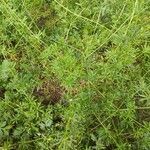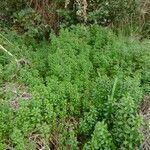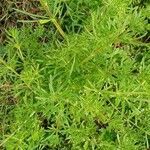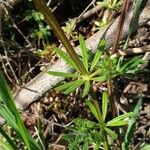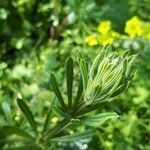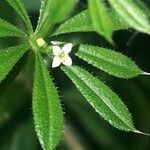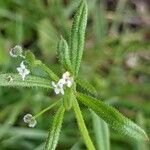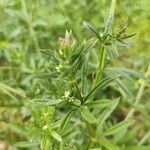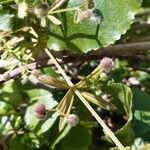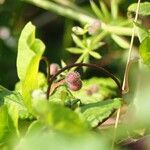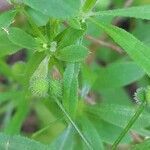Prostrate or scrambling annual; stems to 2 m long when through other vegetation, rather stout, branched, densely clothed in retrorse, hooked, scabrid hairs on the sharply acute angles. Lvs and stipules in whorls of 5-8, sessile, 10-60 × 2-8 mm (sometimes smaller on exposed prostrate shoots), linear-oblanceolate or narrow-elliptic, often spathulate or obovate on exposed lateral shoots; margins flat or nearly so, densely clothed in retrorse, hooked, scabrid hairs; midrib below and surface generally above ± scabrid; apex shortly awned. Fls (1)-2-(6), in axillary divaricating cymes; peduncles usually > pedicels; whorl of bracts at base of pedicels leaflike and scabrid. Corolla 1-2 mm diam., white or whitish; lobes ovate, ± mucronate. Mericarps 2.5-4 mm diam. (excluding bristles), globose or subglobose (often 1 of the pair smaller or abortive), densely furnished with hooked bristles.
Annual 1–10 dm, the stems weak, retrorsely hooked-scabrous on the angles, ± scrambling, seldom much branched; lvs in whorls of (6)8, narrow, 1-nerved, cuspidate, 1–8 cm, retrorsely scabro-ciliate on the margins and often also on the midvein beneath, uncinate-hispid above; infls mostly 3–5-fld, on axillary peduncles or in 3’s on short branches; cor white, 4-parted, 1–2 mm wide; fr uncinate-hispid, or rarely smooth. Damp ground, usually in shade; circumpolar, and found over most of temperate N. Amer. Plants with relatively large frs (mostly 2.8–4 mm, exclusive of the bristles), and with lvs to 8 cm, said to be mainly tetraploid to octoploid (on x=11) are var. aparine. Plantswith smaller frs (mostly 2–3 mm), and the lvs not over 4 cm, said to have usually 2n=20, but sometimes to 2n=66, are var. echinospermum (Wallr.) Farw. (G. spurium; G. vaillantii)
An annual herb. The stems are bristly and sticky. They are square in cross section. It trails over other plants. It climbs by hooked bristles. The leaves are bristly and sprout from the stems in clusters of 6-8. The leaves do not have stalks. The flowers are small and white. The seed pods are bristly and have 2 round segments about 3 mm wide.
